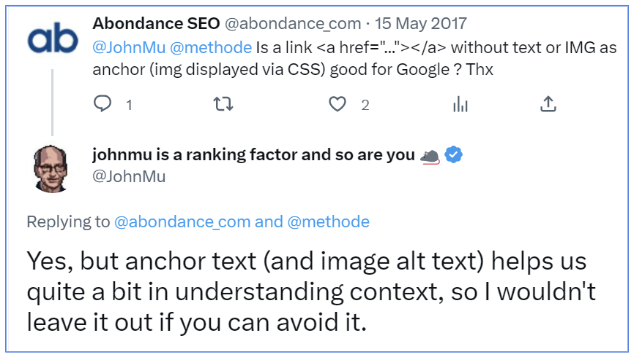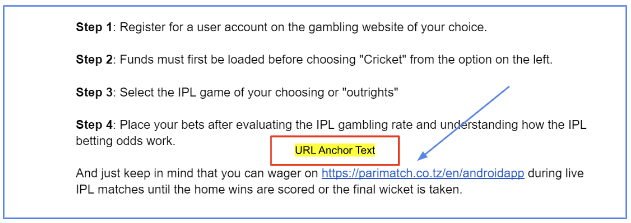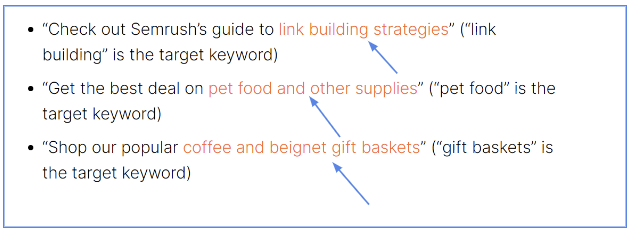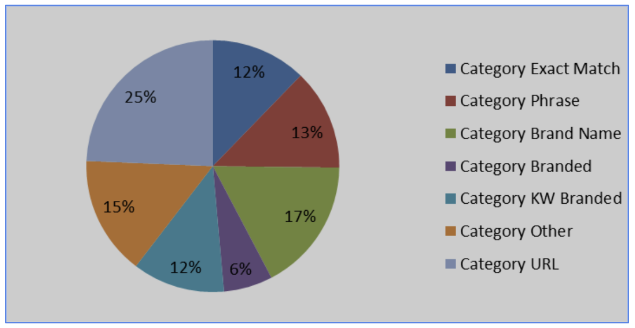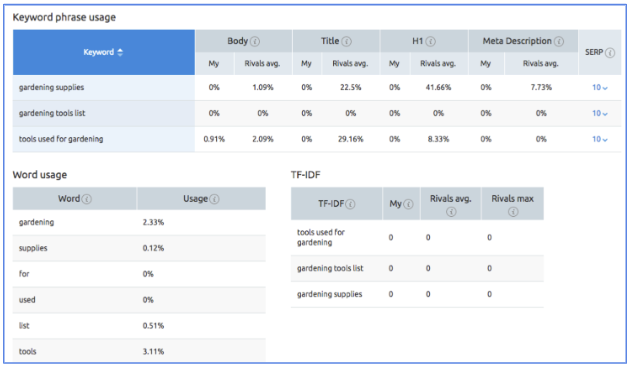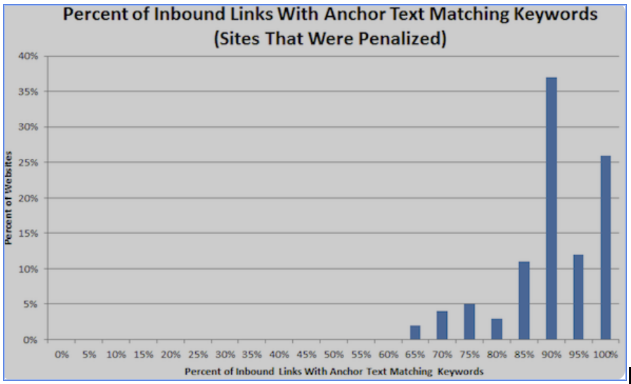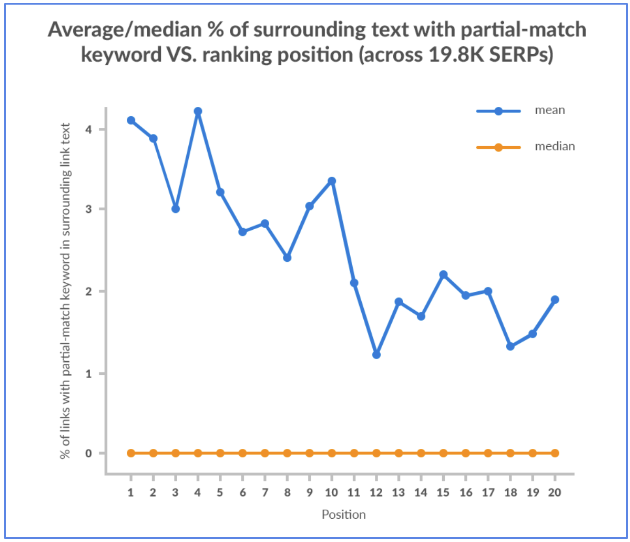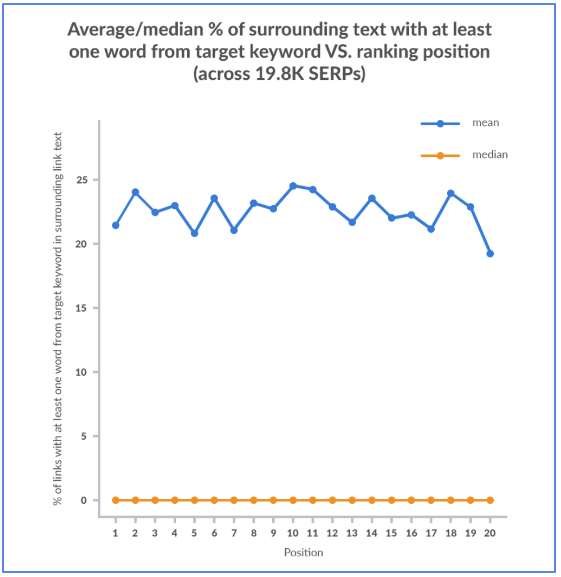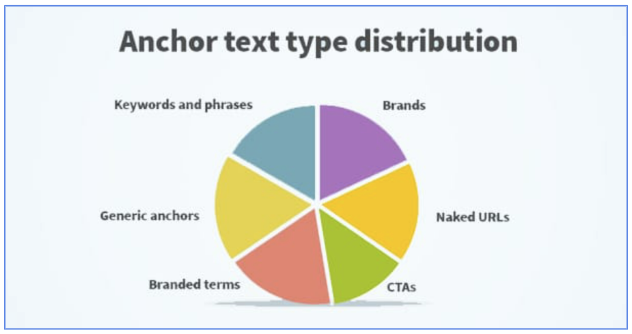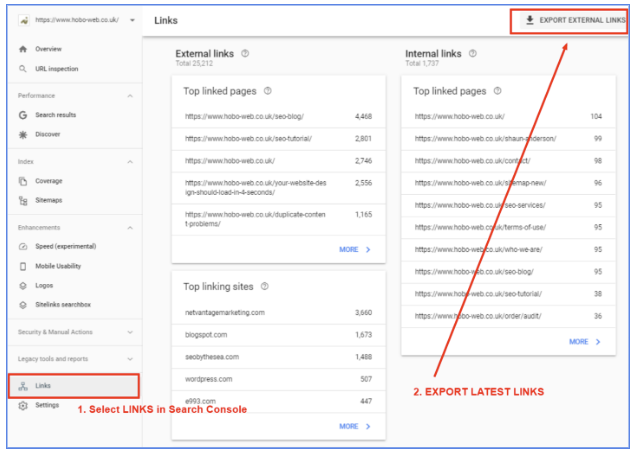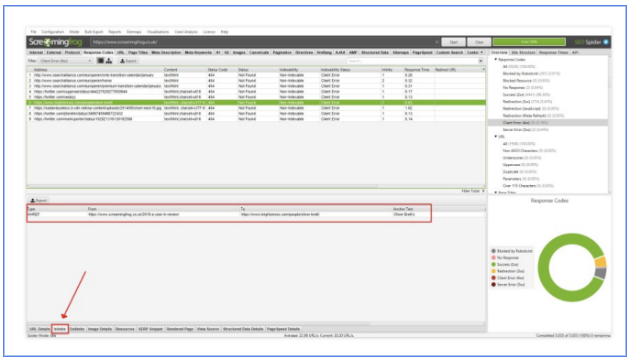1. Introduction To Anchor Text
Link building is one of the most crucial aspects of boosting your website’s search engine ranking. But despite its significance, most SEOs need to pay more attention to the importance of correctly using anchor texts. In fact, in a Twitter thread, one user asked if anchor texts are important when placing links, and this is what John Mueller said:
In addition, studies have shown that most websites have incorrect anchor text usage, leading to a decline in their search engine ranking. However, SEMRush affirms that using relevant, descriptive anchor texts can help boost your search rankings on Google.
As a leading link building company, Rhino Rank regularly builds over 10,000 links per month, giving us a wealth of data and experience to create the ultimate anchor text usage guide for link building. With our expert insights and proven link building strategies, our clients have seen the best success in increasing their online visibility.
In this post, we dive into anchor text usage and provide a comprehensive guide to help you use them correctly and effectively when link building.
2. What Is an Anchor Text?
To understand the importance of anchor texts, it’s crucial to first answer the question: what is anchor text?
Anchor text is the clickable text that appears in a hyperlink that directs the user to another page or website. It is often underlined and appears in a different color than the surrounding text to indicate that it is a clickable link.
The anchor text is a crucial element in link building as it provides context to the linked page and helps search engines understand the relationship between the linked page and the linking page.
For example, consider the following sentence: “pork tenderloin.” In this sentence, the words “pork tenderloin” form the anchor text, and the hyperlink directs the user to the website’s page on pork tenderloin.
In this way, the anchor text is used to give context to the linked page and help the user understand the purpose of the link.
3. Anchor Text Examples
Anchor texts come in different forms and serve different purposes. Let’s take a closer look at some of the most common anchor texts used for SEO purposes.
1. Branded Anchor Text
Branded anchor texts are hyperlinks that contain brand names, logos, or keywords as clickable text. They link a brand’s website or specific web pages to other relevant online resources.
For example, if a brand sells shoes, the anchor text could be “Buy shoes at Brand X,” which would hold links pointing to the brand’s shoe product page. In the anchor text example below, we used BuzzSumo, a platform that helps users discover the best engagement, content, and outreach opportunities across social and search.
Branded anchor texts help to establish brand recognition and improve search engine optimization (SEO) by giving search engines more context on the content of the linked pages.
We highly recommend using branded anchor texts as they can deliver more value to your website. Branded anchor texts are less likely to get penalized by Google’s Penguin algorithm as they are not considered paid or bought by Penguin.
In addition, Google has access to millions of data points on links, so it knows what a natural anchor text profile looks like. In a nutshell, use more branded anchor texts, which are typically seen as more natural.
2. URL Anchor Text
URL anchor texts are clickable text used in a hyperlink linked to another webpage or a specific section within a webpage. They are used to provide a brief description of the target page that the link will direct the user to.
For example, “https://www.rhinorank.io” could be an anchor text linking to our own website Alternatively, we could use “rhinorank.io” too.
Using descriptive and relevant URL anchor text is vital for several reasons:
- It provides context and information to the users about the target page they are clicking to
- It helps search engines understand the context and relevance of the target page, which can affect search engine rankings
- It can improve the overall user experience and make it easier for users to navigate through the website
Therefore, we recommend using descriptive and relevant URL anchor text as it can positively impact both user experience and search engine optimization.
3. Phrase Match
Phrase match anchor text refers to text that matches a target keyword phrase. This type of anchor text is used to signal to search engines the relevance of the target page in relation to the keyword phrase.
For example, if a website has a page about “backlink checker,” they could use anchor text like “Ahrefs backlink checker” when linking to that page from other pages within their site.
This helps to reinforce the relevance of the target page to search engines, which can impact search engine rankings for those keywords.
The importance of using phrase-match anchor text lies in its impact on search engine optimization (SEO). By using relevant and descriptive anchor text, search engines can better understand the context and relevance of the target page, which can improve its visibility in search engine results pages (SERPs).
Additionally, phrase match anchor text can create a clear and consistent information architecture within a website, making it easier for users to navigate and for search engines to crawl and index the site/web page.
4. Partial Match
Partial match anchor texts are hyperlinked words or phrases that only partially describe the linked content. For example, if you have a blog post about “link building,” a partial match anchor text might be “link building strategies”.
In SEO, partial match keywords provide context to the linked content while also appearing natural in the context of the linking page.
For example, if you have a blog post about cooking and want to link to your post on the history of pizza, a partial match anchor text could be “learn about pizza history“.
The importance of using partial match anchor texts lies in their ability to provide context to the linked content in a natural language. Google has access to millions of data points on links and knows what natural anchor text profiles look like.
5. Exact Match
Exact match anchor text is a type of hyperlink that uses the exact keywords for the link as the anchor text. For example, if the link is to a page about “pet supplies,” the anchor text would be “pet supplies.”
Exact match anchor text is often used in SEO (Search Engine Optimization) to help indicate the relevancy of the linked page to the keyword.
The importance of using exact match anchor text lies in its ability to give context to search engines about the content of the linked page. It can improve the link page’s search engine ranking and domain authority if used correctly.
However, using the exact same anchor text excessively can be seen as suspicious by Google. This means that overuse or misuse of exact match anchors can result in penalties from search engines, so it’s essential to use them in moderation and with caution.
6. Generic Anchor Text
Generic anchor text refers to using different and often irrelevant phrases as clickable text in a hyperlink instead of using keyword anchors or a brand name.
For example, if a website wants to link to another page about “dog toys,” the random anchor text might be “click here” instead of “dog toys.”
Generic anchor text is vital in search engine optimization (SEO). It helps diversify the types of text used and appear more natural to search engines. Overusing keyword-rich anchor text can be seen as spammy by search engines and can result in penalties or lower search engine rankings.
7. Combining Anchor Texts
Blended Anchor Text: Blended anchor text contains a mix of target keywords and non-keywords, making it appear more natural and less spammy to search engines.
For example: “Learn more about the latest technology trends” or “Discover the benefits of healthy eating habits” rather than “technology trends” or “healthy eating habits.”
Natural Anchor Text: Natural anchor text uses a sentence or phrase that naturally describes the target page or website without including target keywords.
For example: “Check out this informative article on exercise and weight loss” or “Here is the official website of the government of Canada.”
Exact Match Anchor Text: This type of anchor text uses an exact keyword phrase as the anchor text used to manipulate search engine rankings. However, it is now seen as spammy by search engines and may result in penalties.
For example: “Buy cheap shoes online” or “Best car insurance deals.”
It’s important to note that search engines are becoming increasingly sophisticated, and it’s becoming more challenging to manipulate rankings through anchor text.
Natural and blended anchor texts are considered more trustworthy and provide a better user experience, which is why they are recommended over the exact match anchor text.
4. Anchor Text Best Practices
We understand the significance of anchor text in search engine optimization and its impact on your website’s ranking and domain authority.
That’s why we have carefully curated this section to provide you with actionable tips and guidelines to make the most out of your anchor text strategy.
1. Incorporate Variations
Anchor text is an essential factor in search engine optimization, and using a variety of anchors can help diversify your link profile and make it appear more natural.
You can avoid over-optimization by incorporating a mix of the different types of anchor words we’ve discussed into your SEO strategy.
2. Use Your SEO Title Tag as an Anchor
Using your SEO title tag as an anchor text can help optimize your links and provide valuable context to visitors.
For example, if you have a blog post about “The Best Running Shoes for Women,” you could use the page title tag as the anchor text for the link. This provides search engines and visitors with context about the link and what they can expect to find on the linked page.
3. The Anchor Should Suit the Link Type
The link you create should influence the type of anchor text you use. For example:
- Internal links (links within your own site) can have more branded or generic anchor text, such as “click here” or “read more.”
- External links (links to other websites) should have more targeted anchors, such as an exact match or partial match keyword, to give visitors and search engines context. For example, if you are linking to an article about “The Best Running Shoes for Women,” you could use the exact match keyword as the anchor text: “best running shoes for women.”
4. Don’t Over-Optimize Your Anchor Text
Over-optimizing your anchor text can result in a penalty from search engines, so it’s important to sparingly use “exact match” keywords. Aim for a natural balance of keyword-rich and branded anchor texts, and vary the length and wording of your anchors.
For example, in the blog post about “The Best Running Shoes for Women,” if you want to link to a product page, it’s better to use a mix of anchors such as “Check out our running shoes for women,” “Learn more about the best running shoes,” or “Discover the perfect pair of running shoes.”
5. Pay Attention to the Surrounding Text
The text surrounding a link can provide context and clarify what the link is about to visitors and search engines.
For example, when linking to the product page in the above blog post about “The Best Running Shoes for Women,” it’s better to include a sentence such as “Check out our top pick for the best running shoes for women” or “Click here to buy the best running shoes for women.”
6. Fix Alt Text Issues
Alt text is an essential factor in website accessibility and search engine optimization, and it should accurately describe the image it is associated with.
For example, if you have an image of “Nike Running Shoes,” the alt text should be “Nike Running Shoes.” This not only improves accessibility for users with disabilities but also gives search engines more information about the content of your page.
7. Optimize in Relation to Your URL
When optimizing anchor text, you must consider the URL you’re linking to. The URL and anchor text should be relevant to each other and indicate the content the link is directing users to.
8. Avoid Empty Anchor Text Variations
Empty anchor text, also known as “naked link anchor text” or “URL links,” occurs when a link is displayed as just the URL without any accompanying text. While naked anchor text can be useful for navigation, they are not as effective for search engine optimization. Try to include descriptive text with your links to provide more context for both visitors and search engines.
9. Keep Your Ratios Consistent
Anchor text ratios refer to the distribution of different types of anchor text used in your link profile. Maintaining a natural balance of keyword-rich and branded anchors is important to avoid over-optimization.
For example, if you have ten external links on a page, you might aim for 3-4 keyword-rich anchors, 3-4 branded anchors, and the remaining links to be a mix of generic anchor texts such as “click here” or “learn more.”
10. Keep the Anchor Text Natural
You must keep your anchor text natural and not overly optimized, as search engines can see this as spammy. Write your anchor text in a way that makes sense to visitors and provides them with a clear indication of the link.
For example, instead of using the exact match anchor “best-running shoes for women,” you might use a natural-sounding anchor such as “Find the perfect pair of running shoes for women.”
11. Place Anchor Texts Where Readers Pay the Most Attention
The placement of anchor text can impact its effectiveness, so it’s essential to place it where readers are most likely to notice it. This may be within the main body of text or in a prominent location such as a header or sidebar.
Placing anchor text where readers are likely to see it can increase their chances of clicking on it and improve the relevance signals for search engines.
12. Practice Safe Anchor Text Percentages
The percentage of keyword-rich anchors in your link profile can impact your search engine rankings. Maintaining a safe and natural balance of keyword-rich and branded anchors is important.
We recommend that clients use 60% branded & URL anchor text, 30% partial match, and 10% exact match. However, this can vary depending on the niche and search engine algorithms, so it’s essential to continually monitor your anchor text ratios to ensure they remain within a safe range.
13. Calculate the Perfect Anchor Text Ratio
There is no one “perfect” anchor text ratio that works for all websites, as it can vary depending on factors such as the niche, search engine algorithms, and the overall quality of the link profile.
However, you can calculate your ideal anchor text ratio by analyzing your competition and monitoring your search engine rankings. This allows you to find the right balance for your website gradually.
14. Write Anchors in English, Not SEO-Ese
You should write your anchor text in a way that makes sense to visitors and is easily readable. Writing anchors in “SEO-ese” or using overly optimized or spammy language can negatively impact your search engine rankings and may also turn off visitors.
Anchor text should be written in a natural and readable way, using language that accurately describes the content the link is directing to.
For example, instead of using an anchor like “best running shoes,” you might use a more natural-sounding anchor such as “discover the best running shoes for women here.”
14. Mix Your Anchor Text Usage
Mixing your anchor text is essential because it helps prevent over-optimization of your link profile, which is considered spammy by search engines.
Over-optimization occurs when too many of your backlinks use the same exact anchor text, which can trigger a penalty from Google. By using a variety of anchor text, you make your backlink profile appear more natural, which can help to improve your search engine ranking.
5. Anchor Text Ratios
Anchor text ratio refers to the amount of different anchor texts you have going to your page(s) or website as a whole. This is often classified as a percentage. For example, you might have 40% branded text – which means 40% of your total backlinks contain branded anchor text.
An anchor text ratio which is higher than normal for exact match can indicate that a website is engaging in manipulative link building practices, which can affect its ranking on search engines like Google.
Maintaining a balanced and diverse anchor text ratio is generally recommended to avoid over-optimization and penalties from search engines.
Which is why we recommend our clients mostly stick to branded, phrase and partial match anchor text – with no more than 5% exact match.
Consider Your Anchor Text Keyword Density Too
Anchor text keyword density refers to the proportion of keywords in the anchor text relative to the total number of words in the text. It is a factor used by search engines to determine the relevance and authority of a website or web page.
The higher the keyword density, the greater the emphasis placed on the keyword in the context of search engine optimization (SEO). However, overuse of keywords in anchor text can lead to search engine penalties for spamming, so you should use them in moderation and naturally.
6. Anchor Text & Search Engine Rankings
Anchor text is an important factor in determining the relevance and credibility of a website in the eyes of search engines like Google.
When a website links to another website using anchor text, it is essentially “vouching” for the quality and relevance of the linked site. The anchor text provides context for the linked page and signals to search engines what the linked page is about.
If multiple websites with high authority and relevance link to a certain website using similar or exact anchor text, it can signal to search engines that the linked website is also relevant and credible for those keywords.
Using descriptive, relevant, and varied anchor text is recommended to maximize the positive impact of anchor text on search engine rankings. Avoid using the same anchor text repeatedly, as this can signal to search engines that the linking website is artificially manipulating its rankings.
It’s always important to remember that Google has data on millions of websites – and knows what a natural anchor text profile looks like. It has data on the world’s biggest websites – the likes of Amazon, eBay and Google itself – so trying to beat the algorithm is a nigh impossibility. As such, it’s better to see what a natural anchor text profile looks like – by using tools such as SEMRUSH or AHREFs on large websites – and then trying to mimic those.
7. Impact Of The Google Penguin Algorithm
The Penguin algorithm is a Google search ranking algorithm that was first introduced in 2012.
It targets spammy or low-quality links and link schemes to reduce search engine manipulation and improve the quality of search results, with the algorithm having undergone several updates since its initial release.
The impact of the Penguin update on anchor text usage was significant. Before the update, many website owners and SEOs used exact-match and overly optimized anchor text to manipulate search rankings.
However, with the release of Penguin, such tactics were penalized, and websites that relied heavily on these tactics saw significant drops in their search rankings.
In response to the Penguin update, the best practice for anchor text usage shifted towards using a more diverse range of anchor text, including branded, partial-match, and generic keywords.
The goal is to create a more natural-looking link profile and avoid the appearance of manipulation.
8. Case Studies
The following are two case studies that examine the influence of anchor text and surrounding link text on search engine rankings.
1. Anchor Text Influence Across 19,840 Keywords
The first case study, “Anchor Text Influence Across 19,840 Keywords,” analyzed the impact of anchor text on the ranking of linked-to pages for 19,840 keywords.
The study found that the type and relevance of the anchor text played a significant role in determining the ranking of the linked-to page.
For example, exact match anchor texts were found to have a higher ranking impact than generic anchors, such as “click here” or “read more.” The study also found that the relevance of the anchor text to the content of the linked-to page impacted page rankings.
2. Surrounding Link Text Influence Across 16,000 Pages
The second case study, “Surrounding Link Text Influence Across 16,000 Pages,” evaluated the impact of the content surrounding a link on the ranking of the linked-to page.
The study found that the surrounding text and image alt tags, in addition to the anchor text, can influence the ranking of the linked-to page.
For example, the study found that using keywords in the surrounding text or the image alt tag could improve the ranking of the linked-to page in SERPs.
What Do These 2 Studies Mean to SEOs?
These two case studies significantly affect search engine optimization (SEO) practitioners. SEOs can improve the visibility of their client’s websites in search results by understanding the impact of anchor text and surrounding link text on search engine rankings.
The first case study, “Anchor Text Influence Across 19,840 Keywords,” highlights the importance of using relevant and descriptive anchor text. You can use this information to optimize the anchor text used in your client’s website links.
For example, you can use exact match anchors for targeted keywords to improve the ranking of linked-to pages. Additionally, ensure that the anchor text is relevant to the content of the linked-to page to enhance the page’s ranking further.
The second case study, “Surrounding Link Text Influence Across 16,000 Pages,” underscores the importance of considering the surrounding content when creating links. You can use this information to optimize the surrounding text and image alt tags used in their client’s website links.
For example, you can use relevant keywords in the surrounding text or image alt tags to improve the ranking of linked-to pages.
9. Understand Internal Anchor Text Optimization
Internal anchor text optimization refers to optimizing the text used in hyperlinks within a website to improve its search engine ranking. The four main guidelines for internal anchor text optimization are:
1. Don’t Stuff Keywords
Keyword stuffing is a black hat SEO technique involving using the same keyword repeatedly in the internal link anchor text. This is done to increase the keyword’s relevance for that page in the eyes of search engines.
However, search engines are sophisticated and can detect keyword stuffing, resulting in a penalty for the website. To avoid stuffing exact match anchors, use keywords in the anchor text sparingly and in a natural, contextually relevant way.
2. Don’t Over-Link
Over-linking refers to having too many internal links on a page, which can dilute the impact of individual links and confuse both users and search engines. Too many links can also slow down the page’s loading time, negatively impacting user experience.
To avoid over-linking, limit the number of internal links on a page and prioritize the most important links.
3. Ensure Link Relevancy
Search engines use the relevance of internal links to understand a page’s context and evaluate its quality. For this reason, it’s crucial to ensure that a page’s internal links are relevant to the target page.
For example, if you’re linking to a page about “dog grooming,” the anchor text should include relevant keywords, such as “dog grooming tips.”
This will help search engines understand the link’s context and the relevance of the target page.
4. Opt for Variety
Using a variety of anchor text styles, such as branded terms, generic anchor texts, and long tail keywords, can make the links look natural and diverse.
This can help avoid the appearance of keyword stuffing and make the internal linking structure of a website look more organic.
Additionally, using different anchor text styles can help distribute the link equity across multiple keywords and pages, which can improve the overall search engine ranking of the website.
10. How To Find & Fix Anchor Text Issues
Anchor text issues can harm your website’s SEO ranking and affect user experience. Here are the steps to find and fix anchor text issues:
Use Google Search Console: Check your website’s link profile in the “Links” section of Google Search Console. Look for any unnatural or spammy links and request removal from the linking website.
Check for Over-Optimization: Over-optimized anchor text can lead to penalties from search engines. Look for a high number of links with exact match keywords as anchor text and try to vary the anchor text to be more natural.
Monitor Broken Links: Use a Dead Link Checker or Screaming Frog to identify broken links and correct or remove them.
Update Old Anchor Text: Update any old or irrelevant anchor text to improve the user experience and ensure that the anchor text accurately represents the target page.
Monitor Competitor’s Anchor Text: Keep an eye on your competitor’s anchor text to see if they are using any tactics that could potentially harm your own website.
Fixing anchor text issues is a continuous process that requires regular monitoring and updating. By following these steps, you can ensure that your website’s anchor text is optimized for both users and search engines.
Article Contents 
- 1. Introduction To Anchor Text
- 2. What Is an Anchor Text?
- 3. Anchor Text Examples
- 4. Anchor Text Best Practices
- 5. Anchor Text Ratios
- 6. Anchor Text & Search Engine Rankings
- 7. Impact Of The Google Penguin Algorithm
- 8. Case Studies
- 9. Understand Internal Anchor Text Optimization
- 10. How To Find & Fix Anchor Text Issues


Join 18,000+ Businesses Growing with Rhino Rank
Sign Up

 Back to Academy
Back to Academy